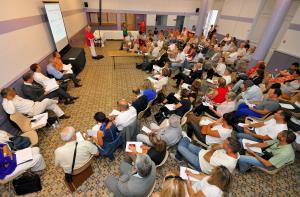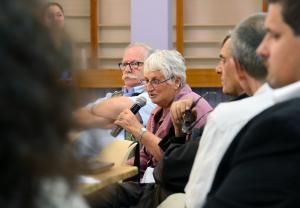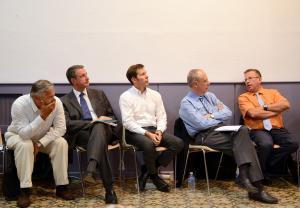Under public scrutiny
Once a year, the ITER Local Commission for Information (CLI)—the independent body that acts as an interface between the ITER Organization and the local population on questions of nuclear safety, radioprotection and the installation's impact on personnel and the environment—organizes a public meeting.
The annual meeting offers the public a unique opportunity to question all the players involved in the ITER Project, either directly or indirectly: the ITER Organization, the European Domestic Agency Fusion for Energy, Agence Iter France, but also the government agencies that "accompany" the implementation of ITER in France.
On Tuesday 1 July, close to one hundred local residents, trade union representatives and community activists gathered in the Vinon-sur-Verdon village hall, 3 kilometers distant from the ITER site, to receive the latest news on construction and manufacturing, projections of the number of site workers required in the years to come and plans for accommodating them.
Following a general presentation by Carlos Alejaldre, ITER Deputy Director-General for Safety, Quality & Security, the Fusion for Energy site project manager, Laurent Schmieder, provided some key figures on ongoing and planned construction works.
Since building construction began in the summer of 2010, 2,500 labourers from 97 companies have worked on the ITER site (an average of 250 to 300 workers are present on any given day).
But things are about to change: as construction ramps up a peak of close to 2,000 workers will be required in 2016-2017—all in all, the construction of the installation (2010-2020) will require 18 million man hours. Beginning in the third quarter of 2015, machine assembly operations will follow a similar pattern and a peak of 1,500 workers is expected in 2018-2020. These figures bring the total of worksite employees to more than 3,000 between mid-2017 and late 2018.
This planned increase in activity has created great expectations in the towns and villages surrounding ITER where unemployment is high.
Working "upstream," government agencies are setting up training programs to ensure that local habitants, and especially the unemployed, have a chance to benefit from ITER worksite activity. "Everyone is mobilized," explained Gilles Barsacq, the Secretary General for Regional Affairs. "According to estimations, as much as half of the ITER worksite needs could be filled by local companies and local recruitment—that is, provided we can match the needs and available skills."
While the prospective employment opportunities have raised high hopes for the local population, the expected influx of workers has created some concern. Will the local infrastructure be sufficient to guarantee decent accommodation to the workers? How will transportation be organized to and from the worksite?
Three years ago, Agence Iter France began working on these issues in close cooperation with local institutions. Jerôme Pamela, the Agency's director, explained that solutions have been found for the first wave of 250 workers who are due on the worksite at the end of this year/beginning of next and that the ongoing projects in the neighbouring towns and villages "will cover the anticipated needs."
As for transportation, the creation of two large parking areas located in villages north and south of the ITER site, plus a shuttle system, should largely contribute to limiting the increase in traffic on the local roads.
And finally, on the recurrent questions about working conditions on the ITER site, it was once again emphasized that—despite the international status of the ITER Organization—French and European labour regulations will apply to each and every worker, as is the rule on any worksite in France.




